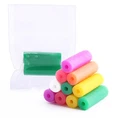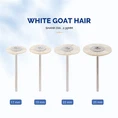Can dental matrix bands be used in resin - modified glass ionomer restorations?
In the field of dentistry, the choice of materials and tools for restorations is crucial to ensure the success and longevity of dental treatments. Resin - modified glass ionomer (RMGI) has gained significant popularity in recent years due to its unique properties, such as fluoride release, adhesion to tooth structure, and biocompatibility. On the other hand, dental matrix bands are commonly used to create a temporary wall for restoring the proximal surfaces of teeth. The question arises: Can dental matrix bands be used in resin - modified glass ionomer restorations?
Understanding Resin - Modified Glass Ionomer Restorations
Resin - modified glass ionomers are a hybrid material that combines the advantages of traditional glass ionomers and resin composites. They are composed of a glass powder and a liquid, which can be water - based or resin - based. The setting reaction of RMGI involves both an acid - base reaction, similar to traditional glass ionomers, and a light - activated polymerization reaction, like resin composites.
This dual - setting mechanism provides several benefits. The initial acid - base reaction allows for early strength development, while the subsequent light - activated polymerization enhances the final mechanical properties of the restoration. RMGIs are known for their ability to bond to tooth structure without the need for a separate bonding agent in many cases, and they release fluoride over time, which can help prevent secondary caries.
The Role of Dental Matrix Bands
Dental matrix bands are thin, flexible strips of metal or plastic that are placed around the tooth to create a temporary mold for the restoration material. They are essential for restoring the proximal surfaces of teeth, especially in cases where the contact area needs to be re - established. Matrix bands help to create a well - contoured restoration, prevent overhangs, and ensure proper contact between adjacent teeth.
There are different types of dental matrix bands available, including stainless steel, T - band, and sectional matrix systems. Each type has its own advantages and is suitable for different clinical situations. For example, stainless steel matrix bands are strong and durable, making them suitable for posterior teeth restorations, while T - bands are more flexible and can be easily adapted to the tooth surface.
Using Dental Matrix Bands in Resin - Modified Glass Ionomer Restorations
The use of dental matrix bands in RMGI restorations is indeed possible and can offer several advantages. One of the main benefits is the ability to create a well - contoured restoration. RMGI has a relatively high viscosity compared to some other restorative materials, and without a matrix band, it can be challenging to achieve the desired shape and contour. A matrix band provides a physical barrier that guides the placement of the RMGI, resulting in a more aesthetically pleasing and functional restoration.
In addition, matrix bands help to prevent the extrusion of RMGI into the gingival sulcus. Overhanging restorations can lead to inflammation of the gingival tissues, plaque accumulation, and ultimately, periodontal problems. By using a matrix band, the dentist can ensure that the RMGI is confined within the desired area of the tooth, reducing the risk of these complications.
However, there are also some considerations when using dental matrix bands in RMGI restorations. One of the main issues is the potential for moisture contamination. RMGI is sensitive to moisture during the setting process, and if moisture gets between the matrix band and the tooth surface, it can affect the bonding and the final properties of the restoration. Therefore, proper isolation techniques, such as the use of rubber dams or cotton rolls, are essential to prevent moisture from interfering with the restoration.
Another consideration is the removal of the matrix band. RMGI has a relatively high coefficient of thermal expansion compared to tooth structure, and if the matrix band is removed too early, the restoration may shrink and develop gaps at the margins. On the other hand, if the matrix band is left in place for too long, it can be difficult to remove without damaging the restoration. Therefore, the dentist needs to carefully time the removal of the matrix band based on the setting characteristics of the RMGI used.
Complementary Products for RMGI Restorations
When performing RMGI restorations with dental matrix bands, other complementary products can also be used to enhance the outcome. For example, Plastic Dental Wedges are commonly used in conjunction with matrix bands. Plastic dental wedges are placed in the interproximal space to separate the teeth slightly and create a better seal between the matrix band and the tooth surface. This helps to prevent the leakage of the RMGI material and ensures a more accurate restoration.
Another useful product is the Disposable Dental Prophy Brush. After the restoration is completed, a prophy brush can be used to polish the surface of the RMGI restoration. Polishing not only improves the aesthetics of the restoration but also reduces the roughness of the surface, which can help prevent plaque accumulation.
Our Dental Matrix Bands as a Supplier
As a leading supplier of Dental Matrix Bands, we understand the importance of providing high - quality products for dental professionals. Our dental matrix bands are made from the finest materials, ensuring strength, flexibility, and durability. We offer a wide range of matrix bands to suit different clinical needs, including stainless steel, T - band, and sectional matrix systems.
Our matrix bands are designed to be easy to use and adapt to the tooth surface. They are available in various sizes and shapes, allowing dentists to choose the most appropriate one for each patient. In addition, we are committed to providing excellent customer service and technical support. Our team of experts is always ready to assist dentists with any questions or concerns they may have regarding the use of our dental matrix bands in RMGI restorations or other dental procedures.


Conclusion
In conclusion, dental matrix bands can be effectively used in resin - modified glass ionomer restorations. They play a crucial role in creating well - contoured restorations, preventing overhangs, and ensuring proper contact between adjacent teeth. However, proper isolation techniques and careful timing of matrix band removal are essential to achieve optimal results.
If you are a dental professional looking for high - quality dental matrix bands for your RMGI restorations or other dental procedures, we invite you to contact us for more information. Our products are designed to meet the highest standards of quality and performance, and we are confident that they will meet your needs. We look forward to the opportunity to work with you and contribute to the success of your dental practice.
References
- Feilzer AJ, de Gee AJ, Davidson CL. A comparison of the physical properties of resin - modified glass - ionomer cements. J Dent Res. 1995;74(1):635 - 642.
- Cvek M, Bjurlin C. Clinical evaluation of resin - modified glass - ionomer cement in Class II restorations. Quintessence Int. 1997;28(10):673 - 678.
- Van Dijken JW. Resin - modified glass - ionomer restorations: a 10 - year follow - up study. J Dent. 2002;30(6):367 - 373.




